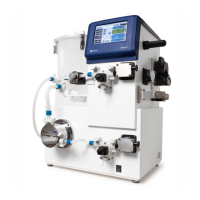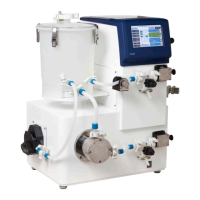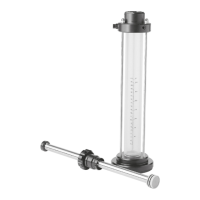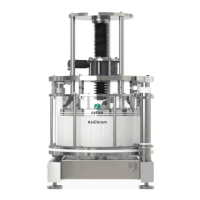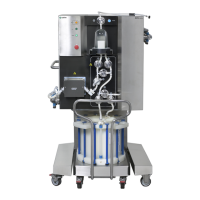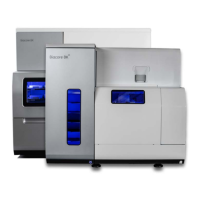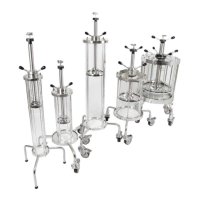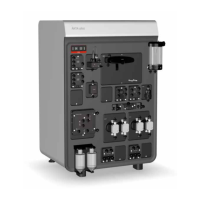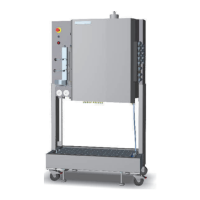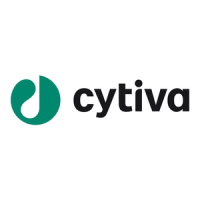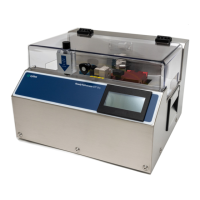Do you have a question about the cytiva F9-R and is the answer not in the manual?
This chapter contains information about the manual and associated documentation.
Provides essential information for users regarding product operation and safety.
Defines the intended application of the Fraction collector F9-R for purification runs.
Outlines the necessary knowledge and system familiarity required for operating the product.
Explains the purpose, scope, and typographical conventions used within the manual.
Details the text formatting conventions used in the manual for clarity.
Lists and describes related user documentation and where to find it.
Details how to access help and documentation for the UNICORN software.
This chapter describes safety precautions, labels, symbols, and emergency procedures.
Covers general and specific safety precautions for operating the fraction collector.
Defines WARNING, CAUTION, and NOTICE terms used for product safety.
Provides essential safety guidelines for operating and maintaining the Fraction collector F9-R.
Details safety precautions when handling flammable liquids with the fraction collector.
Emphasizes the importance of using appropriate personal protective equipment.
Highlights safety considerations specifically for the installation process.
Provides crucial safety advice related to the operation of the fraction collector.
Details safety precautions and procedures for maintaining the fraction collector.
Instructions for safe cleaning procedures before decommissioning the equipment.
Provides guidelines for keeping the fraction collector clean and dry.
Explains the meaning of product labels, symbols, and regulatory markings.
Describes the information provided on the system label located on the back of the equipment.
Outlines procedures for emergency shutdown and actions in case of power failure.
Describes how to perform an emergency shutdown of the fraction collector.
Explains the consequences of power failure or communication loss on the instrument.
This chapter provides an overview of the Fraction collector F9-R and its accessories.
Details the primary functions and applications of the Fraction collector F9-R.
Provides visual representations of the Fraction collector F9-R and its components.
Illustrates the main parts of the fraction collector from the front view.
Shows the main parts of the connector panel on the fraction collector.
Describes the types and specifications of tubes compatible with the Fraction collector F9-R.
Illustrates the components and assembly of the tube rack for the fraction collector.
This chapter provides information on preparing and performing the installation of the fraction collector.
Details the necessary preparations and requirements for installing the fraction collector.
Provides requirements for receiving the delivery box and storing the fraction collector.
Describes the recommended placement options and space needed for the fraction collector.
Details recommended locations for placing the fraction collector.
States the physical dimensions and weight of the fraction collector.
Outlines the specific site requirements for installing the fraction collector.
Specifies environmental conditions necessary for the proper functioning of the equipment.
Details how to connect the fraction collector to the ÄKTA instrument for power and communication.
Explains the steps for connecting power and communication cables between the collector and ÄKTA instrument.
Step-by-step instructions for connecting the fraction collector using a UniNet-9 cable.
Details how to configure the fraction collector within the UNICORN software.
Describes how to use the Edit dialog in UNICORN to select the fraction collector component.
Explains how to check and change the Node ID for the fraction collector.
Provides instructions for connecting the tubing for fractionation from the collector to the ÄKTA instrument.
Step-by-step guide for connecting the tubing from the fraction collector to the ÄKTA instrument.
Details how to connect tubing to different outlet valves (V9-O, V9-Os).
Explains how to set the delay volume in UNICORN for accurate fraction collection.
Step-by-step instructions for setting the delay volume between the UV monitor and fraction collector.
Describes running a performance test to verify the equipment's function before use.
This chapter describes how to prepare and assemble the fraction collector before a run.
Outlines steps to prepare the fraction collector for operation, including settings and assembly.
Provides instructions for assembling the tube rack for the fraction collector.
Instructions for inserting the tube support into the bowl of the tube rack.
Instructions for inserting the tube guide into the tube support.
Instructions for inserting and securing the tube holder in the tube rack assembly.
Instructions for moving the delivery arm and placing the tube rack.
Guides on how to insert collection tubes correctly into the tube rack.
Step-by-step instructions for adjusting the height and position of the delivery arm.
Details on adjusting the delivery arm height relative to the collection tubes.
This chapter provides instructions for cleaning the fraction collector.
Specifies when cleaning of the fraction collector is required.
Lists the materials needed for cleaning the fraction collector.
Step-by-step instructions for cleaning the exterior of the fraction collector.
This chapter lists technical specifications, chemical resistance, and regulatory information.
Provides detailed technical specifications and environmental requirements for the fraction collector.
Lists key technical parameters such as flow rate, voltage, dimensions, and weight.
Outlines environmental conditions required for the operation and storage of the equipment.
Refers to the ÄKTA instrument manual for chemical resistance specifications.
Provides information on decommissioning, decontamination, and disposal of the product.
States that the product must be decontaminated before decommissioning.
Details how to separate and recycle materials according to environmental regulations.
Mentions the presence of hazardous substances and where to find more information.
Instructs on the proper disposal of electrical and electronic waste.
Lists regulations and standards applicable to the product, including regional information.
Provides contact details for support and manufacturing information.
Directs users to cytiva.com/contact for local support and troubleshooting.
Summarizes the manufacturer's name, address, and telephone number.
Details regulatory information applicable to the EU and EEA, including CE marking.
Describes the CE marking and its validity conditions for the instrument.
Provides regulatory information for the Eurasian Economic Union member states.
Summarizes manufacturer and importer details relevant to Eurasian Economic Union regulations.
Explains the EAC symbol indicating compliance with Eurasian Economic Union markets.
Covers FCC and ICES/NMB compliance applicable to products in the USA and Canada.
Details FCC compliance rules and conditions for the device.
States compliance with Canadian standards for electromagnetic compatibility.
Presents regulatory statements applicable to regional requirements, including EMC emission.
Provides a statement regarding EMC emission classification for business use.
Describes information applicable to the product in China regarding hazardous substances.
Explains the meaning of the Chinese pollution control label and EFUP.
Table listing hazardous substances, their concentration, and compliance with GB/T 26572.
Provides a form for declaring the health and safety status of equipment before service.
Details requirements for equipment and work areas for Cytiva service personnel.
Form for declaring equipment status for product return or servicing, including contamination checks.
| Brand | cytiva |
|---|---|
| Model | F9-R |
| Category | Laboratory Equipment |
| Language | English |
